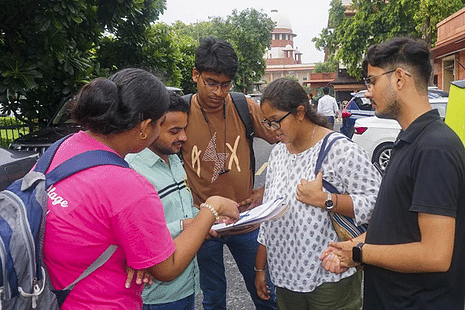To enhance the regular preparation for NEET UG 2025, candidates should practice some questions daily. Here are NEET Daily Practice Questions for 20 November 2024.
 NEET Daily Practice Questions 20 November 2024
NEET Daily Practice Questions 20 November 2024NEET Daily Practice Questions 20 November 2024: Aspirants preparing for the NEET 2025 shall refer to the below-mentioned NEET Daily Practice Questions 20 November 2024. These questions cover important topics from subjects like physics, chemistry, and biology. They can analyze their strengths and weaknesses in a particular subject by working through these questions and reviewing the answers. It can help them to perform better in the upcoming NEET 2025 exam.
Also Read | JEE Main DPP 20 November 2024: Daily practice problems for 2025 aspirants
NEET Daily Practice Questions 20 November 2024: Physics
Here are some of the NEET daily practice questions with answers 20 November 2024:
Question 1: The percentage errors in the measurement of mass and momentum of an object are 1% and 2% respectively. The percentage error in the measurement of kinetic energy of the object is:
1. 1%
2. 3%
3. 4%
4. 5%
Answer: (4)
Question 2: The pressure experienced by a swimmer below the water surface in a lake is appropriately
[Given density of water = 103 kgm−3, g = 10 ms−2 and 1 atm = 105 Pa]:
1. 1 atm
2. 2 atm
3. 3 atm
4. 4 atm
Answer: (2)
Question 3: A vernier caliper has marks on the main scale. It has 20 equal divisions on the vernier scale which match with 16 main scale divisions. The least count of this vernier calipers is:
1. 0.02 mm
2. 0.05 mm
3. 0.10 mm
4. 0.20 mm
Answer: (4)
Question 4: An object falls freely from height h above the ground. It travels 5/9h in the last 1 s. Then height h is:
1. 5 m
2. 25 m
3. 45 m
4. 58 m
Answer: (3)
Question 5: Zener diode works:
1. In forward bias only
2. In reverse bias only
3. As voltage regulator in forward bias and as a simple pn junction diode in reverse bias
4. As voltage regulator in reverse bias and as a simple pn junction diode in forward bias
Answer: (4)
NEET Daily Practice Questions 20 November 2024: Chemistry
Here are some of the NEET daily practice questions with answers 20 November 2024:
Question 1: Which one of the following molecules is paramagnetic?
1. H2
2. Li2
3. C2
4. O2
Answer: (4)
Question 2: The method used for quantitative estimation of halogens is:
1. Dumas method
2. Carius method
3. Kjeldahl's method
4. Combustion method
Answer: (2)
Question 3: Given below are two statements:
Statement I: Benzoic acid produces effervescence on treatment with aq. NaHCO3
Statement II: The effervescence is due to release of hydrogen gas
In the light of the above statements, choose the most appropriate answer from the options given below:
1. Both Statement I and Statement II are correct
2. Both Statement I and Statement II are incorrect
3. Statement I is correct but Statement II is incorrect
4. Statement I is incorrect but Statement II is correct
Answer: (3)
Question 4: The technique used to purify liquids having high boiling points and getting decomposed at or below their boiling points is:
1. fractional distillation
2. steam distillation
3. simple distillation
4. distillation under reduced pressure
Answer: (4)
Question 5:
The common oxidation state shown by actinoids is +3 with the other oxidation states being +4, +3, +6, and +7. The number of oxidation states shown by the following elements decrease in the order:
A. Np(Z − 93)
B. Am(Z − 95)
C. Ac(Z − 89)
D. Pa(Z − 91)
Choose the correct answer from the options given below:
1. A > B > D > C
2. A > B > C > D
3. B > A > D > C
4. D > B > A > C
Answer: (1)
NEET Daily Practice Questions 20 November 2024: Biology
Here are some of the NEET daily practice questions with answers 20 November 2024:
Question 1: Which of the following statements is not correct?
1. Rhizome is a condensed form of stem
2. The apical bud in rhizome always remains above the ground
3. The rhizome is aerial with no distinct nodes and internodes
4.The rhizome is thick, prostrate and branched
Answer: (3)
Question 2: To ensure that only the desired pollens fall on the stigma in artificial hybridization process :
(a) the female flower buds of plants producing unisexual flowers need not be bagged.
(b) there is no need to emasculate unisexual flowers of selected female parent
(c) emasculated flowers are to be bagged immediately after cross pollination
(d) emasculated flowers are to be bagged after removal of anthers
(e) bisexual flowers, showing protogyny are never selected for cross
Choose the correct answer from the options given below:
1. (a), (b) and (c) only
2. (b), (c) and (d) only
3. (b), (c) and (e) only
4. (a), (d) and (e) only
Answer: (2)
Question 3: The residual persistent part which forms the perisperm in the seeds of beet is :
1. Calyx
2. Endosperm
3. Nucellus
4. Integument
Answer: (3)
Question 4: The chromosomal theory of inheritance was proposed by :
1. Thomas Morgan
2. Sutton and Boveri
3. Gregor Mendel
4. Robert Brown
Answer: (2)
Question 5: Which of the following protects nitrogenase inside the root nodule of a leguminous plant ?
1. Catalase
2. leghaemoglobin
3. Transaminase
4. Glutamate dehydrogenase
Answer: (2)
Also Read | |
|---|
JEE Main DPP 19 November 2024: Daily practice problems for 2025 aspirants |
NEET Daily Practice Questions 19 November 2024: DPP for 2025 aspirants |


 Follow us
Follow us














